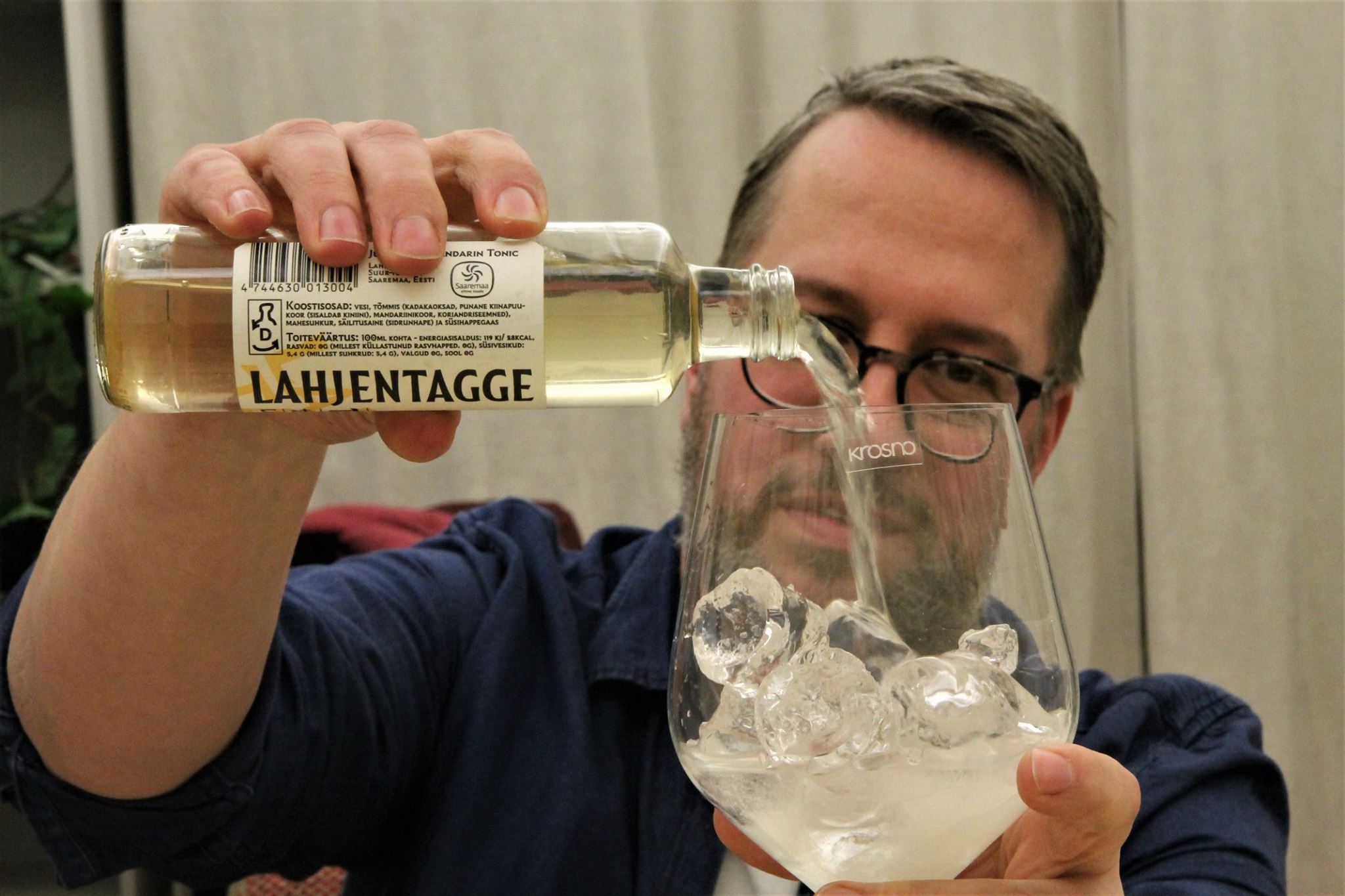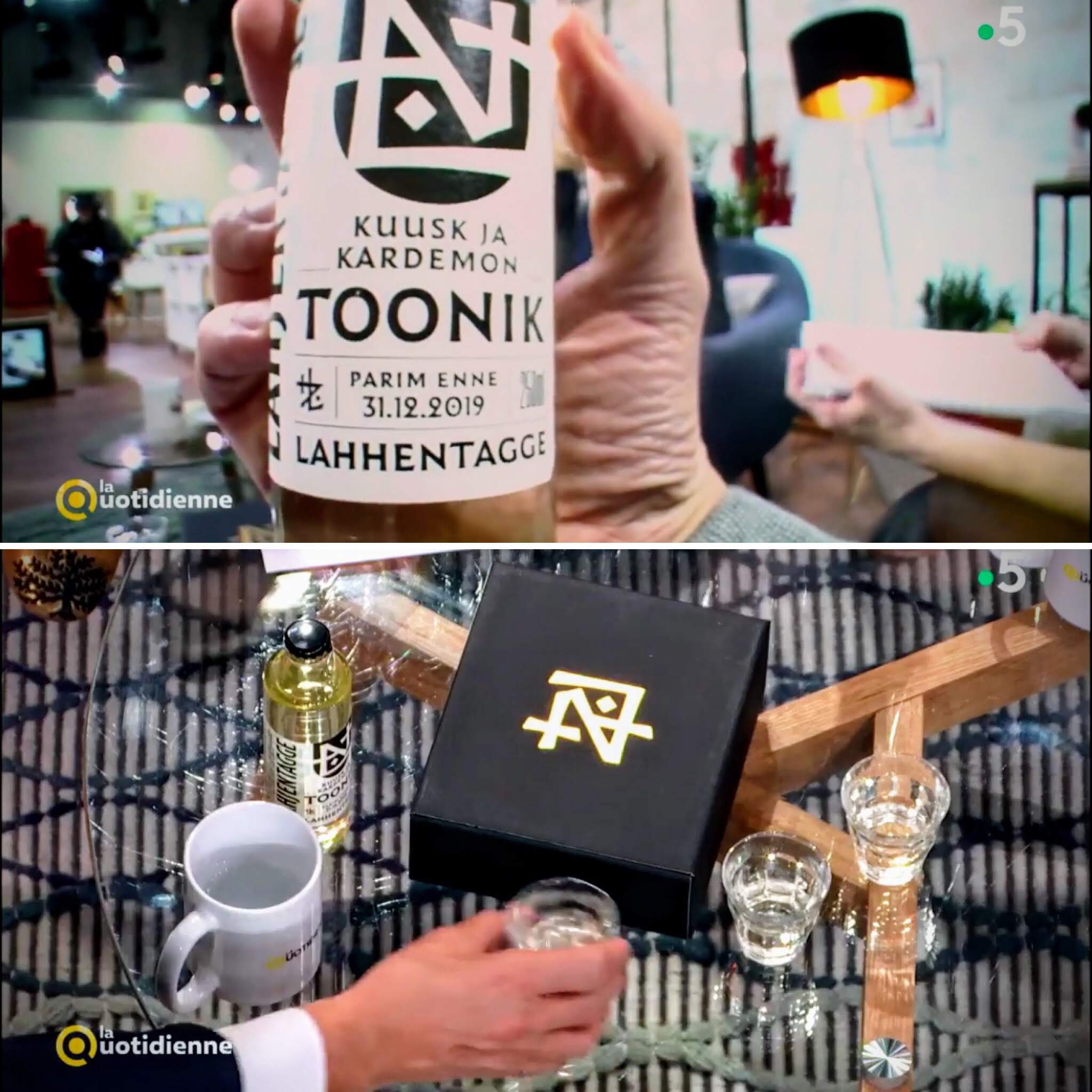For the third year in a row, we are recycling Kuressaare city Christmas tree into EstonicSoda tonic water.
"One Christmas tree at a time"
“Taking into account the minerals and the vitamins you can find in a spruce tree, and the number of spruce trees that are cut every Christmas, this is a massive opportunity to change the world – one Christmas tree at a time.”
How To Choose The Perfect Tonic Water For Your Gin
Gin and tonic is a great combination of drink, suitable for a lot of occasions. However, you need to be sure to choose the perfect tonic to get the right taste. There are a lot of quality tonic water out there, and knowing what to look for will save you time and stress.
We collected some tips for picking the best tonic water for your gin.
Check The Bottle
The first thing to do when choosing a tonic water is to check the ingredient list and everything you need to know about it. The kind of container, as well as the things it contains goes a long way in determining the quality of the tonic. Some of the clues in the bottle are discussed right below.
- Carbonation: The level of carbonation determines the quality of tonic, which is why it is best to ditch the two-liter supermarket brands and go for tonic in glass. The carbonation holds better in glass and your tonic certainly tastes better. You can choose the champagne-sized bottles, for parties and elaborate events.
- Sweetener: The quality of a sweetener determines to a large extent how a tonic tastes. You therefore should avoid sweeteners like high fructose corn syrup, rather go for sweeteners like agave syrup and cane sugar. On the other hand, if you are a lover of vodka tonic, floral-flavoured tonics is an excellent choice for you.
Light Versions?
The process of producing tonic water is basically the act of balancing bitter and sweet. This is why you must look for the perfect blend, just so your gin and tonic does not have a bad taste. Tonic water requires an adequate amount of sweetener to match the bitter quinine. In reality, this sweetener might be too much for people who are sugar-averse, therefore prompting them to go for diet/light version tonics.
Often times than not, these light versions are made with unpleasant tasting sweeteners. It is therefore usually best to avoid them altogether and go for normal tonic. You can then add carbonated water to your tonic to reduce the sugar level. That way, the taste stays enjoyable while watering down the sugar.
Careful With Syrups
Typically a DIY approach, tonic syrup allows you to add your soda when making tonic. There are some things to keep in mind when going about this process.
- Cinchona Bark: Rather than isolated quinine, tonic syrup are usually made with ground up cinchona bark. This is a more natural solution, but it leaves syrups (and some tonic waters which use the bark) looking brownish, rather than clear, as well as a little bit bark tasting. Overdosing on cinchona alkaloids may be harmful for your health, which is why it is important to filter the bark solids thoroughly.
- Carbonation: Adding tonic syrup to your gin or even carbonated water, will leave your drink with very little carbonation. A very good solution is to pump your Soda Stream, this way carbonation is increased.
Overall, it is best to shop smart; paying attention to detail, and purchase professionally made tonic if you have trouble making yours.
All You Need To Know About Tonic Water
The origin of tonic water is a fantastic tale; the drink was created out of necessity rather than curiosity; as it is with a lot of inventions.
Tonic water was first made by British soldiers. In the 19th century, British Soldiers sought a way to consume the extremely bitter malaria antidote, quinine. They mixed quinine with water and soda to make it taste better. It, however, was still too better to consume, and they found a solution to this by adding gin. Going by this, the British army invented the tonic water.
In following years, 1858 in particular Erasmus Bond carried out the first commercial production of tonic water. In 1878, 20 years after that, Jacob Schweppe began production of Schweppes Indian Tonic.
Quinine
Quinine is a well-known medication used to treat malaria. It is, however, no longer recommended as a result of its numerous side effects. Quinine was gotten for the first time from the bark of a Peruvian Cinchona tree around 1630. The Cinchona tree is native to South and Central America, and can also be found in West Africa and the Caribbeans. Back then, it was used to treat fever before its potency for malaria was discovered.
Quinine played a massive role during the second world war, as it was used in treating many soldiers. The last American plane which was taken over by the Japanese after flying out of Philippines was said to have carried about four million quinine seeds.
An interesting take on the importance of quinine to soldiers can be taken from Sir Winston Churchill's statement:
''Gin and tonic have saved more Englishmen's lives and minds than all the doctors in the empire''.
Medicinal Benefits Of Quinine
The primary use of quinine is for malaria treatment, although as a result of its numerous side effects, this was discontinued. It is still used in small quantities alongside newly discovered malaria antidotes.
Quinine also acts as a food additive, giving tonic water its bitter and unique taste.
Reports have also claimed that it is used to treat cramps.
Uses Of Tonic Water
• Mixer: Tonic water is one of the most common mixers around the world. It forms the classy gin and tonic duo, and can also be mixed with vodka. It is also used for mixing cocktails.
• Cramps: Some have claimed that tonic water treats restless legs and cramps. This will, however, require the consumption of a high volume of tonic, as its quinine content is around 83mg per litre. The recommended daily consumption between 500mg and 1000mg per litre.
• Other Uses: According to research, tonic can be used to water plants and remove cloth stains as well.
Tonic water has a long and rich history remaining widely relevant since the 19th century. Gin and tonic is a standard fixture in bars and clubs, as well as cocktails at dinners and parties.
The Fine Line Between Tonic Water And Soda Water
Tonic water has become a trendy drink in recent times. Vodka tonic, gin and tonic and even plain tonic water are consumed in homes, as well as bars and clubs. Tonic water is different from other carbonated drinks, and in this article, we are examining the thin line between tonic water and soda water.
What Is Tonic Water?
Tonic water is a carbonated drink, containing some mineral which gives it a distinct taste. The unique ingredient in tonic water is quinine; which gives the drink its bitter taste. It is an alkaloid gotten from the bark of a native Peruvian tree. To reduce the bitterness caused by quinine, sweeteners from nectar or sugar are added to the tonic. Carbonation also offsets the bitter taste. Tonic is a popular ingredient for cocktails as well as being a top-notch beverage when combined with gin.
What Is Soda Water?
Soda water is also a carbonated drink, infused with salt and minerals. Soda water usually contains dissolved carbon dioxide gas. It does not contain added sugars or preservatives. Soda water is a common ingredient for a cocktail, particularly used along with vodka or gin.
Similarities Between Tonic Water And Soda Water
• Carbonated Water: Both share the same base, which is highly carbonated water. This is the most important component of both drinks. This similarity is highlighted in the history of Coca-Cola, which was first created as a tonic with alcohol and coca leaves added.
• Mineral And Compounds: Both drinks contain different minerals and compounds. It is what gives them their distinct tastes.
• Mixers: Both drinks act as mixers and are added to cocktails, gin, as well as vodka. Although their uses vary, they are both standard mixers.
• They can both be taken as plain drinks. Although tonic waters typically have a bitter taste, some of them, like Lahhentagge tonics, can still be consumed as plain drinks.
Differences Between Tonic Water And Soda Water
• Quinine: Tonic water and soda water are similar, as they have the same base of carbonated water. The ingredients they contain, however, make them taste different. Quinine, the prominent ingredient in tonic water makes it bitter, compared to soda water.
• Calories: Tonic water contains sugar as well as other sweeteners, and this makes it high in calories. Soda water does not contain preservatives or added sugars, making it calorie-free.
• Ghrelin: Tonic water has calories, while soda water increases ghrelin. Ghrelin is a hunger hormone, and with the more soda water you consume the higher your hunger levels. This, when not watched, can lead to weight problems.
In conclusion, the difference is in quinine -- it is more healthy to lean towards tonic water, especially if you check sugar-level of your tonic.
Take it plain or mix it with gin for the best taste.
Kuressaare Christmas Tree Adventures in World Media
One tree, one Christmas - dozens of stories in more than half a dozen languages.
Among the first, Italian blogs Federvini.it and Aisitalia.it wrote about how the Kuressaare Christmas tree was about to become a tonic water.
In Britain, FoodBev.com included our story in the wider context of the Christmas tree problem. The story was also run on the Brazilian Revista-fi page. In Romania, we can be found on Roaliment.ro.
In French the story is here on Pour Nourrir Demain, while the tonic made its way onto the popular French TV show La Quotidienne.
In Russia, the adventures of our Christmas tree were covered in Upakovano.ru, FoodMarkets.ru, Miromalo.club, Prostoest.ru, Cookingdom.ru, Siatrus.ru, Gloss.ee, Kedem.ru, Zdorovaya-life.ru, Stolitsa.ee, Food-Berdsk.ru, Kushatj-podano.ru, Toluna, Murmsil on ok.ru, Astv.ru, Borgi.ru, Justpovar.ru, prodgoroda.ru and pakko.me.
On top of the Russian coverage, the Christmas tree also started to pop out in texts like this - 爱沙尼亚蒸馏商Lahhentagge从圣诞树中提取汤力水. Here are a few links for those of you who might speak Chinese better than we do: kknews.cc, ifooday.cn, bbltbz.com, jianshu.com, yidianzixun.com, 3g.163.com and zhuanlan.zhihu.com.
Among our Nordic neighbours, the story of our tonic made it into Glorian Ruoka ja Viini magazine.
Finally, the Christmas tree story made it to some 50+ smaller media outlets across the United States. Among those were affiliates of ABC, CBS, NBC, and even Fox.
Clearly, recycling raw materials is something people care and feel deeply about and the food industries can do a lot in this field.
Kuressaare Christmas tree: recycled!
The Estonian town of Kuressaare, capital of Saaremaa island, will fully recycle its 55-feet tall Christmas tree this year. Ater the spruce tree has served its 2-month duty in the town's central square, its needles and branches will be used for local Lahhentagge tonic water.
The Vitamin Tree of Vikings
Old Tjikko, whose name could well belong to an ancient Viking Warrior, is a small tree in Western Sweden. At a mere 4 metres, it’s tiny compared to most trees in the Nordic forests.


















